|
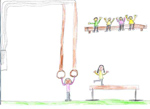 The
idea The
idea
Schoolchildren
think up a story and then figure out how to tell that story in pictures/images.
They produce these pictures (drawing/painting/photography, etc.) and publish
them on a central internet site.
Other
schoolchildren see these pictures and 'rewrite' the story in them in their own
words. These story interpretations get published on the site as well, connected
to the original images.
The
primary aims: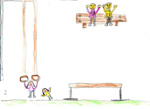
to
communicate
with children far away without initial dependance on speaking eachother's language;
to
learn
about the relationships between language and images/to 'think in images';
to
learn
how culture affects the way we use and interpret images.
The
secondary aim:
 to
make contact with children elsewhere in the world, learn about their culture and
serve as a starting point for further communication/new projects and ideas. to
make contact with children elsewhere in the world, learn about their culture and
serve as a starting point for further communication/new projects and ideas.
The
history
Credit
for the original idea must go to primary school ‘De Caroussel’ in Apeldoorn,
the Netherlands, which first organized a similar project in 2001 on a small
scale. In the 2002-2003 schoolyear Ard Hesselink adapted the idea and, with the
support of the Dutch division of
IEARN (International Education and Resource Network), executed a
trial project which ran from January to June 2003.
 Many
schools reacted favourably and 14 schools actually participated: from India (7),
the Netherlands (4), Latvia (1), Ukraine (1) and USA (1). (See below) In all 31
stories were published, virtually all of which were rewritten by at least one
but often three or four different schoolclasses. Originally the idea was that
the schools would publish their images on their own school websites but it
immediately became clear that a central website was needed. Ard Hesselink's
homepage served as such for the duration of the pilot project. Many
schools reacted favourably and 14 schools actually participated: from India (7),
the Netherlands (4), Latvia (1), Ukraine (1) and USA (1). (See below) In all 31
stories were published, virtually all of which were rewritten by at least one
but often three or four different schoolclasses. Originally the idea was that
the schools would publish their images on their own school websites but it
immediately became clear that a central website was needed. Ard Hesselink's
homepage served as such for the duration of the pilot project.
Pressing
selection
stories 2003 will give you an idea of the kind of results the trial project yielded.
The Results
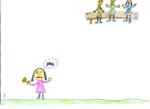 Evaluating
the trial project afterwards Hesselink and IEARN realized two things: Evaluating
the trial project afterwards Hesselink and IEARN realized two things:
1.
the concept was very successful and appealed greatly to both teachers and
students;
2.
in order to proceed with it on a long term basis a separate, interactive
website would have to be developed, which would allow schools to upload
images and 'rewrites' themselves into a predetermined format.
IEARN
offered to host such a website, once it was designed. During the 2004-2005 schoolyear Hesselink worked with students from
Hogeschool
Utrecht, the Netherlands, college of Communication Systems to try and develop
such a website. Unfortunately this yielded too few results.
The future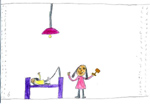
At
this moment Hesselink is investigating options to collect the funds necessary
for having the site designed professionally. Anybody interested in
cooperating on this and/or with knowledge of possible subsidy sources, please,
get in touch!
contact
Ard Hesselink
Schools participating in
pilot project:
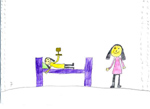 SRI
AUROBINDO INT’L SCHOOL, VIDYA
NEGAR, HYDERABAD, INDIA, BAI
KABIBAI ENGLISH SCHOOL AND JUNIOR COLLEGE, MUMBAI, INDIA, BINODINI
GIRLS HIGHSCHOOL, KOLKATA,
WEST BENGAL, INDIA, GURU
NANAK ENGLISH HIGHSCHOOL, NAVY
NAGAR, MUMBAI,INDIA, OXFORD
HIGHSCHOOL, MUMBAI, INDIA,
MADHAVRAO
BHAGWAT HIGHSCHOOL, INDIA,
SHREE
N.D. BHUTA HIGHSCHOOL, MUMBAI, MAHARASHTRA, INDIA,
VAN
REENENSCHOOL, BERGEN,
THE NETHERLANDS, SLOTERMEERSCHOOL,
AMSTERDAM,
THE NETHERLANDS, DE
MIJLPAAL, AMSTERDAM, THE NETHERLANDS, DE
KRIJTMOLEN, AMSTERDAM,
THE NETHERLANDS, ENGURE
SECONDARY SCHOOL, ENGURE,
LATVIA, SCHOOL
4, YUZHNOUKRAINSK,
UKRAINE, COVENTRY
VILLAGE SCHOOL, COVENTRY, VERMONT, USA SRI
AUROBINDO INT’L SCHOOL, VIDYA
NEGAR, HYDERABAD, INDIA, BAI
KABIBAI ENGLISH SCHOOL AND JUNIOR COLLEGE, MUMBAI, INDIA, BINODINI
GIRLS HIGHSCHOOL, KOLKATA,
WEST BENGAL, INDIA, GURU
NANAK ENGLISH HIGHSCHOOL, NAVY
NAGAR, MUMBAI,INDIA, OXFORD
HIGHSCHOOL, MUMBAI, INDIA,
MADHAVRAO
BHAGWAT HIGHSCHOOL, INDIA,
SHREE
N.D. BHUTA HIGHSCHOOL, MUMBAI, MAHARASHTRA, INDIA,
VAN
REENENSCHOOL, BERGEN,
THE NETHERLANDS, SLOTERMEERSCHOOL,
AMSTERDAM,
THE NETHERLANDS, DE
MIJLPAAL, AMSTERDAM, THE NETHERLANDS, DE
KRIJTMOLEN, AMSTERDAM,
THE NETHERLANDS, ENGURE
SECONDARY SCHOOL, ENGURE,
LATVIA, SCHOOL
4, YUZHNOUKRAINSK,
UKRAINE, COVENTRY
VILLAGE SCHOOL, COVENTRY, VERMONT, USA
|